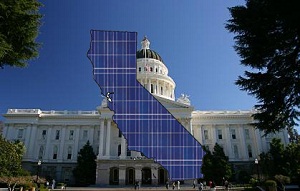California commission cautions ‘not so fast’ on building out solar, wind
 California’s been building out its wind, solar and other renewable energy resources at a rapid pace over the past few years as it races to meet its renewable portfolio standard (RPS) of 33 percent renewables by 2020. But a new report out from the state’s Little Hoover Commission—which lauds the effort—cautions that the state’s electric customers may face soaring utility bills unless the state reorganizes its energy agencies.
California’s been building out its wind, solar and other renewable energy resources at a rapid pace over the past few years as it races to meet its renewable portfolio standard (RPS) of 33 percent renewables by 2020. But a new report out from the state’s Little Hoover Commission—which lauds the effort—cautions that the state’s electric customers may face soaring utility bills unless the state reorganizes its energy agencies.
The Little Hoover Commission is tasked with making sure California’s government and its executive branch operates efficiently, economically and with the public’s wishes in mind. The chief concern the commission has with electricity and rates in California is an ongoing one. “California’s path to success, however, is complicated by a balkanized energy governance structure, a subject of concern to the Little Hoover Commission for nearly 40 years,” wrote commission chair Daniel W. Hancock in a letter to Gov. Jerry Brown (D) and the state’s legislative leaders. The report was requested by commission member State Sen. Mark Wyland (R).
At the same time the state is boosting its renewables, it’s also implementing the Global Warming Solutions Act of 2006, which aims to reduce California’s greenhouse gas emissions to 1990 levels by 2020. “For the health of the state’s environment and its economy, it is critical for California to get this transformation right. California cannot afford another energy policy failure. Ratepayers still bear the cost of the state’s flawed energy deregulation, which badly bruised the state’s reputation for policy innovation,” Hancock said.
The risks are various, according to the report. The report contended that each of the policy initiatives would take years of careful planning to implement on their own. And each was adopted separately, but without the benefit of a cohesive design. “Now they are being implemented simultaneously without an overarching plan,” it said. It also noted that California has not produced a comprehensive assessment of the overall cost of implementing these policies. It contended that the lack of insight into future energy costs doesn’t allow consumers and businesses to plan for the future. It also found that the state lacks the ability to keep the policies in check as their implemented.
It recommended three solutions to keep the state on the right path. It recommended that the governor direct regulators, including the California Energy Commission, the California Public Utilities Commission, the California Air Resources Board, the State Water Resources Control Board and other appropriate executive branch organizations to address the concerns. It also recommended that the governor establishes a plan to prioritize energy goals of today and tomorrow to maximize progress on the goals. Finally it determined the governor and legislature should modernize California’s energy governance.
Read the report here.



